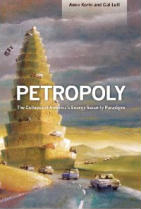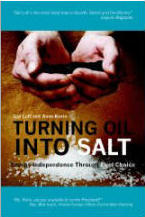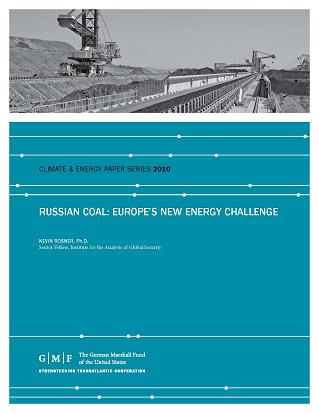On March 9, 2007 President Bush, in conjunction with Brazil’s President, Lula da Silva, announced the formation of a new partnership between the two countries. Capitalizing on the strength of the ethanol industry in both countries, the partnership was aimed at the broad goals of developing new ethanol production technologies, sharing resources and promoting the use of ethanol as an alternative to fossil fuel. Brazil is currently the world’s leading producer and exporter of ethanol and the United States follows close behind.
This ethanol partnership merits a close examination as its effects could be extraordinarily far-reaching. An increase in the already large-scale ethanol industry in the US and Brazil could portend a similar increase in harmful environmental effects on a national and international level. For example, there is evidence to suggest that an expansion of ethanol production in any country necessarily demands an expansion of land area used to grow the crops from which ethanol is produced (primarily corn in the US and sugar cane in Brazil). If crop production for ethanol use proves to be economically viable for farmers and large industries, such expansion could push crops used for food to marginal or protected land, or largely eliminate land currently used for food production. Additionally, questions still surround the level of harmful emissions created both from the mobile sources that use ethanol as well as emissions from ethanol plants themselves. Debate over the efficiency of ethanol production remains unresolved. Critics point to data that questions the overall net energy used to produce ethanol in comparison to production of fossil fuels. Additionally, large monocultures of corn or sugar cane could be disastrous to surrounding ecosystems.
The litany of questions and controversies surrounding ethanol are especially relevant in light of the current ethanol production boom in the United States. However, this is not the first time an industrial nation has attempted to create and promote a massive ethanol production industry. Starting in 1975, Brazil began a national program to promote ethanol production, setting a goal to produce 3.5 billion liters of ethanol by the year 1980. The program met and vastly exceeded that goal allowing Brazil to become the world's largest producer of ethanol for domestic and international use. Before the US embarks on a full-scale national promotion of the ethanol industry, it would do well to look to Brazil’s program noting both the successes and missteps the country has made along the way.
History of Brazilian Ethanol Production
Brazil is currently the world’s leading producer and exporter of ethanol for fuel. The ethanol industry in the country is based, almost exclusively, on the use of sugar cane. Sugar cane production has historically been concentrated in two main areas in the country, the Northeast, in the states of Algoas and Pernambuco and the Center-South, in the state of Sao Paulo. The ethanol industry has expanded enormously in the past three decades due largely to strong governmental incentives and pro-ethanol legislation.
Brazil has historically had a robust sugar cane production industry, and in the years before the national ethanol program was initiated, a great number of sugar cane plantations were owned and operated by smaller, independent growers. Without additional processing, such as milling sugar, producing ethanol, or producing derivatives sugar cane in and of itself possesses little economic value. As a result, those individuals who are in control of the sugar mills essentially control the industry.
Though sugar cane production has its origins in the colonial era in Brazil, it only became a direct part of the Brazilian government’s economic plan in 1933 with the creation of the national agency, the Institute of Sugar and Alcohol (IAA). In 1941, the Sugar Cane Agriculture Statute was enacted and created a quota system for sugar cane production. The IAA was charged with determining the production level for all growers, large or small, independent or mill owners. In an effort to protect smaller, independent farmers, the act created a guarantee that at least 60% of all sugar cane would be provided by independent farmers. The quota system, though, had an opposite effect.
Apart from the 1941 statute and sundry other statutes and resolutions, other economic and social factors contributed to the steady decline of smaller, independent sugar cane farmers in Brazil. During the international sugar boom of the early 1970s, the Brazilian government temporarily suspended the quota system of the 1941 statute to allow farmers to take advantage of higher sugar prices. By relaxing its constraints on the amount of sugar a single farmer could produce, the government spurred a dramatic increase in the amount of sugar cane grown by large-scale producers. This led to the rapid expansion of large-scale mills as they were better equipped to produce sugar more efficiently than smaller, independent mills. Additionally, there was no legal restraint on the amount of land a sugar producer could buy, leading to larger producers assimilating smaller, struggling farmers.
With greater and greater economic incentive to produce ethanol from the sugar cane crop, large-scale growers slowly co-opted the traditionally smaller, individual farmers in Brazil. By 1975, the sugar cane industry in Brazil was dominated by a small, elite group of large-scale farms which provided over 60 % of sugar cane production. The emergence of the large-scale farmers as a political and economic powerhouse in the sugar cane industry had a disastrous effect on the independence of smaller-scale farmers. The total number of sugar mills declined substantially in the twenty-five years before 1975. Fewer mills, combined with increased total land area of larger farms meant that the distance between independent growers’ farms and the end destination of the crop, the sugar mill, often increased.
The Creation of Proalcool
Established on November 14, 1975 by presidential decree, Proalcool (Programa Nacional do Álcool) was created at a time of great flux in the international sugar industry. The oil crisis of 1973 had sent gasoline prices soaring internationally and the Brazilian government decided to look to possible domestic sources of fuel production in order to insulate itself from the chaotic market. The program was aimed at bolstering Brazil’s national sugar economy by safeguarding the privately owned sugar industry.
The Proalcool mandate was simple enough to implement as alcohol plants already in operation required only simple modifications to produce ethanol. Proalcool’s specific mandate was to produce 3.5 billion liters of ethanol from sugar cane by 1980. For comparison’s sake: in the year before Proalcool was initiated, 1974, the nation had 130 ethanol distilleries which produced 625 million liters of ethanol from sugar cane.
In the first years after the creation of Proalcool, sugar prices were stabilized as many existing sugar plants expanded or constructed alcohol fermentation and distillation processes, turning millions of tons of surplus sugar into ethanol. Even though at the inception of Proalcool the Brazilian sugar industry was the largest in the world, the continued mandate to increase production of ethanol required substantial subsidies for farmers and producers.
In order to boost the domestic market for ethanol, the government instituted an ever-changing mandate of blending ethanol with gasoline to be sold to consumers. The blending percentages were in great flux in the first years as the government adapted to consumer interest in the product and transporting the product across the country.
In the early years after Proalcool, ethanol was produced nearly exclusively by existing sugar mills that had expanded their distillation capacity. While this allowed the existing sugar cane industry to minimize their initial investments, it eventually led to several long-term consequences for the industry as a whole.
[I]t forged an indissoluble link among sugar cane cultivation, the sugar industry, and alcohol production. Second, rather than developing a technology distinct from that of the sugar sector, the program adopted the technology of the sugar industry as it existed in 1975. The Program thereby limited itself to an agro-industrial structure based largely in a single state and under the control of an elite that had consolidated itself and its privileges during the past half century.
One of the most innovative government programs to emerge from the late 1970s in Brazil was the agreement brokered between the Brazilian government and large automobile manufacturers to produce cars that ran on ethanol alone, rather than simply a blend of ethanol and gasoline. On September 19, 1979, major automobile manufacturers signed an agreement with the federal Brazilian government that created a protocol that defined aims of mass production ethanol-only vehicles.
The 1979 protocol was extremely ambitious in its scope. The aim was to produce 250,000 ethanol-only vehicles by 1980, 300,000 by 1981 and 350,000 by 1982. The first ethanol-only vehicles appeared on the streets in 1978. In order to help raise awareness of the new vehicle, priority for these vehicles was given to governmental fleets. The government also mounted a comprehensive information campaign about the vehicles.
Thus, the goal of Proalcool became more far-reaching. Rather than acting as simply a short-term bolster of the sugar industry, it became a full-fledged energy program. The ethanol production mandate was raised to 10.7 billion liters by 1985 and following a government-sponsored protocol issued in 1979, all major auto makers in Brazil were required to phase in ethanol-consuming cars and phase out gasoline cars. This increase in production was achieved by constructing new distilleries rather than simply modifying existing plants. By 1985, 85%-90% of Brazil’s new cars were alcohol powered. Two million of the total of ten million cars were fueled completely by ethanol, the rest were fueled by gasohol.
Why Sugar Cane?
The use of sugar cane as the crop of choice for ethanol production in Brazil is the result of several historical factors. The Proalcool decree allowed for the use of either sugar cane or manioc root for the production of ethanol. Manioc, native to South America, is easily cultivated in the region and has traditionally been grown as a subsistence crop. While Proalcool offered subsidies to both manioc-based plants and sugar cane-based plants, the de facto standard in the alcohol industry was the 120,000 to 240,000 liter per day facility, a scale that far exceeded the typically smaller manioc plants.
While ethanol-producing sugar cane plants have increased their efficiency over the years and have been able to minimize the net energy used to create ethanol, there is evidence to suggest that manioc could be a more energy efficient alternative to sugar cane as a ton of manioc yields much more alcohol than a ton of sugar cane. Additionally, manioc is grown very easily in all areas of the country, not just the major sugar cane strongholds that exist in three Brazilian states. The choice of sugar cane over manioc as the preferred ethanol crop was not directly mandated by the government, but by the existing sugar cane farmers and producers who made sugar cane appear a more viable alternative. The infrastructure of a massive sugar cane industry had already been established in the country and well-financed farmers and plant owners were able to convince additional investors that sugar cane ethanol production made more economic sense than alternatives such as manioc.
Land Use Concerns
Though sugar cane production is concentrated mainly in two geographic regions of Brazil, the Northeast and the Center-South, dramatic land use changes are evident in both those regions since the establishment of Proalcool. Less than 1% of Brazil’s total territory would be needed to reach production of 30 billion liters of alcohol per year. However, the area in which sugar cane production is most concentrated has experienced the negative effects of a large monoculture crop. A monoculture is the growing of only one species of crop, grown densely over a large land area. As such, monocultures require increased use of pesticides, since the area would be an ideal location for crop pests and diseases to grow. Monocultures require vast areas of land, and therefore can lead to the destruction of natural habitats.
By allowing very fertile agriculture production areas, such as Sao Paulo, to be devoted to sugar cane necessarily drove other crops out of the area, driving up the price of traditional food crops. Not only are traditional food crops forced to move to other areas, the price of land surrounding sugar cane plantations has seen a dramatic increase since the creation of Proalcool. Additionally, the practice of subsidizing one primary crop for ethanol production, especially a crop that is dominated by a relatively few large-scale farmers, implies the denial of similar subsidies to other crops or producers.
What the United States Can Learn from Brazil?
In the United States, there are currently 134 corn-based ethanol plants in operation compared with 95 in January 2006. There are currently 77 more plants under construction and many more in various stages of planning. Ethanol production has vastly increased in the US in the past three decades. According to the Renewable Fuels Association, in 1980, the US produced 175 million gallons of ethanol. In 2006, it produced 4,855 million gallons. Currently, 26 states have ethanol plants, the vast majority of which use corn as their sole feedstock. The boom in ethanol and ethanol plants has driven up the price of corn, which in turn, has driven up the supply. In 2007, US farmers planted more acres of corn than at any time since 1944 (90.5 million acres) and 15% more acres than in 2006.
The parallels between the development of the sugar cane-based ethanol industry in Brazil and the current state of the corn-based ethanol industry in the US should be informative to anyone who can envision room for improvement in the US system. In the years before Proalcool was initiated, the sugar cane industry in Brazil had steadily amassed political support for a sugar cane-focused industry. By the time Proalcool was initiated in 1975, through a combination of market forces, government incentives, and political will the industry was controlled largely by a few elite producers. In 2006, in the US, there were 46 farmer-owned ethanol plants, nearly half of the total number of ethanol plants in the country. However, of the 134 plants currently operating, only 49 of those are farmer-owned. Certainly, the US ethanol industry seems to be heading in the direction of the Brazilian ethanol industry of the early 1970’s with a decrease in smaller, independent ethanol plants and a corresponding increase in large industry operated plants.
Diversification of US Feedstock
A major lesson the United States could learn from Brazil is the need to diversify feedstock used for ethanol production. As analyzed above, Brazil, through a mixture of government incentives, market forces and political maneuvering found itself with sugar cane as its main crop. This occurred in Brazil even though the initial statute mandating the creation of the national alcohol program, Proalcool, specifically mentioned not only sugar cane as a potential feedstock but also manioc root.
A potential parallel to manioc root in the United States is switchgrass. Switchgrass is a rapid-growth perennial plant that can grow to around six feet in height and is native to North America. One of the great benefits of large-scale use of switchgrass for ethanol production would be that marginal land could be used rather than land currently used for food production. Switchgrass would fall in the category of cellulosic feedstock used for ethanol production, which is quickly emerging as a very viable alternative to traditional ethanol feedstock.
The US Department of Energy (DOE) has designated switchgrass as a potential biomass energy crop, chosen because it produces more biomass than most other native grasses. The DOE has experimented with hybrids of poplar and willow trees as they were better suited to differing climates. Cellulosic crops such as switchgrass are preferred for several environmental reasons: they are able to hold the topsoil, capture carbon, aid in cleaning and purifying runoff and can provide habitats for indigenous wildlife.
The case of switchgrass is simply one of many possible feedstock alternatives to corn in the ethanol production industry. Ethanol has, and could be made from, a variety of feedstocks. Through improvements, certainly by conducting more research on a greater number of alternative crops, this will provide other possible feedstock solutions. The US should, however, learn from Brazil’s insistence on maintaining a monoculture of sugar cane for its ethanol industry. Clearly diversification of biomass feedstock for ethanol could yield both environmental and economic benefits.
Additionally, another relevant lesson the US could learn from Brazil is in the area of industrial initiatives. By working closely with major automobile manufacturers, the Brazilian government was able to set extraordinary goals for the production of flex fuel cars. Perhaps even more extraordinary was the fact that these goals were met by the manufacturers. Simply by looking at the Brazilian model, it is clear that such initiatives are well within the grasp of the US government should it decide to proceed down that path. Indeed, measures and agreements on not only ethanol additives, but fuel economy as well as a host of environmental initiatives are possible to foresee. The example of Brazil leaves little to doubt as to the possible success of such programs. With governmental backing, industry support and informed consumers, such industrial initiatives could readily be adopted in the US.
Environmental Concerns
Many of the criticisms leveled against the Proalcool program can find parallels in programs implemented in the United States to boost corn-based ethanol production. A state-supported national push to produce ethanol implicitly excludes many other environmentally beneficial energy-reducing alternatives. In choosing to address its petroleum crisis by producing alcohol, Brazil underwrites the most energy-inefficient form of transport - the private automobile.
Certainly, that is a criticism that could be raised any time a government favors one system of alternative energy over another, but it is especially relevant in the US where, for example, a great deal of improvement could be made in the fuel economy of cars. The promotion of ethanol need not be at the exclusion of increased fuel economy, but by heavily promoting renewable fuels, the US Administration seems to be able to deflect attention from other possible improvements in energy efficiency. Brazil chose to invest in ethanol. Whether that investment was a conscious decision to exclude other alternatives is left to debate. However, Brazil lacks other environmentally-minded transportation systems, such as a national rail system. The allocation of resources to Proalcool limited or denied the possibilities of other methods of reducing petroleum imports. These rather substantial opportunity costs must be recognized, for Proalcool represents a heavy drain on the national treasury and non-investment in other critical sectors. Ethanol use need not be a Faustian bargain between renewable energy and any other alternative plan or program.
As American farmers proceed to plant the largest corn crop since 1944, a bumper crop heavily influenced by a record number of corn-based ethanol plants under construction, the US must seriously consider the long-range effects such a pattern will have on other staple crops in the country. The rush to plant corn would come at the cost of other crops, particularly soybeans and cotton. The Agriculture Department said that if farmers followed through with their stated intentions, soybean acreage would be down 11% and cotton, 20%. A necessary ripple effect will occur if corn planting continues at this breakneck pace. Not only will other staple food crops be affected, but industries that depend on such crops will be competing directly with ethanol plants for the same raw materials. The effect of this profound boom in corn acreage will have on not only other staple food crops in the nation but also on those industries that depend on corn is difficult to determine. Looking to Brazil as an example, the US can learn much from the Brazilian model. Sugar cane monocultures in the states of Sao Paulo and in the Northeast region of the country drove out smaller, independent farmers as well as drastically increased the price of surrounding land. While the vast size of the country has allowed for the planting of ever more sugar cane acreage without significantly affecting the production of staple food crops, such a situation is not feasible in the US. The demand for corn for ethanol production has already taken a toll on corn prices as well as on the acreage of other staple food crops. In order to combat this trend, the US should think seriously about increasing the diversity of crops used for the production of ethanol.
Conclusion
The United States currently sits at a crossroads in the ethanol debate. The major players in the ethanol industry are heavily invested in corn-based plants and production, virtually to the exclusion of all other feedstock. Before the US plunges ever further into an ethanol production system that depends on a single crop, it would do well to look at Brazil's ethanol history. Spanning over the past three decades, Brazil offers a rich and detailed case history of a government-backed push to rapidly and exponentially increase its ethanol production levels. Set against the backdrop of the oil crises in the mid 1970's, the Brazilian Proalcool program offers many parallels to the current political and economic climate in the United States. Certainly, the uniqueness of the Brazilian authoritarian political system at the time of Proalcool's inception sets it apart, but should the US decide to follow Brazil's path, many of the governmental incentives, subsidies and regulations could be emulated and modified for the American political system.
Through diversification of the ethanol feedstock as well as forging agreements with large auto manufacturers to produce ethanol-friendly cars, the US could both adopt the successes of the Brazilian model of ethanol production as well as avoid several environmental dangers. Brazil used a variety of governmental incentives, subsidies and mandates and was clearly affected by changes in the market since the inception of the Proalcool program. The government, however, was able to adapt quickly to such changes and modified programs and mandates to match new economic realities. The debate over whether ethanol is truly the best solution to US fuel concerns could easily be the subject of another paper of similar length. However, if the US continues to careen towards exponential growth in the ethanol production sector, it would be wise to learn from the lessons Brazilian history can teach us.
Vanessa Cordonnier is Assistant Attorney General in the Environmental Bureau of the Office of the Illinois Attorney General. This article was revised by the author and was originally published in the William & Mary Environmental Law & Policy Review, Volume 33, Issue 1



 Archive
Archive 










